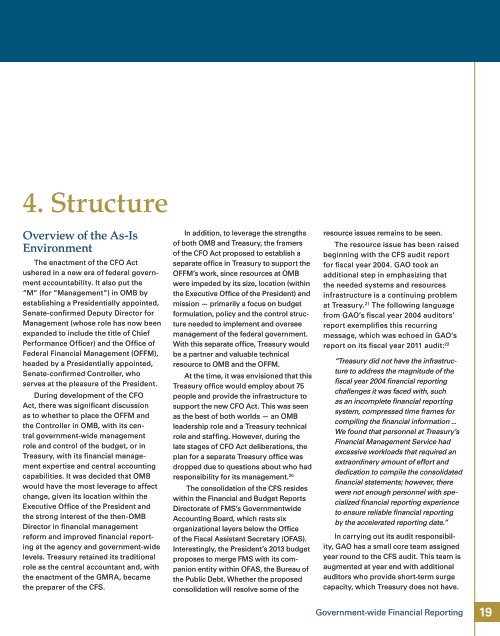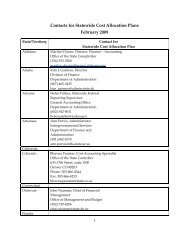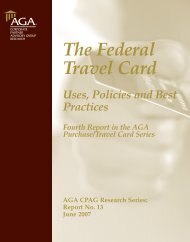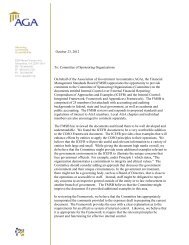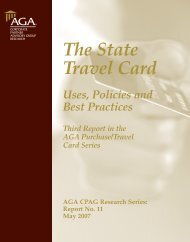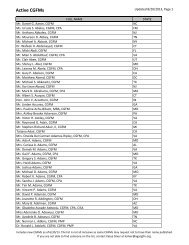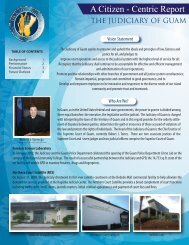Government-wide Financial Reporting - AGA
Government-wide Financial Reporting - AGA
Government-wide Financial Reporting - AGA
Create successful ePaper yourself
Turn your PDF publications into a flip-book with our unique Google optimized e-Paper software.
4. Structure<br />
Overview of the As-Is<br />
Environment<br />
The enactment of the CFO Act<br />
ushered in a new era of federal government<br />
accountability. It also put the<br />
“M” (for “Management”) in OMB by<br />
establishing a Presidentially appointed,<br />
Senate-confirmed Deputy Director for<br />
Management (whose role has now been<br />
expanded to include the title of Chief<br />
Performance Officer) and the Office of<br />
Federal <strong>Financial</strong> Management (OFFM),<br />
headed by a Presidentially appointed,<br />
Senate-confirmed Controller, who<br />
serves at the pleasure of the President.<br />
During development of the CFO<br />
Act, there was significant discussion<br />
as to whether to place the OFFM and<br />
the Controller in OMB, with its central<br />
government-<strong>wide</strong> management<br />
role and control of the budget, or in<br />
Treasury, with its financial management<br />
expertise and central accounting<br />
capabilities. It was decided that OMB<br />
would have the most leverage to affect<br />
change, given its location within the<br />
Executive Office of the President and<br />
the strong interest of the then-OMB<br />
Director in financial management<br />
reform and improved financial reporting<br />
at the agency and government-<strong>wide</strong><br />
levels. Treasury retained its traditional<br />
role as the central accountant and, with<br />
the enactment of the GMRA, became<br />
the preparer of the CFS.<br />
In addition, to leverage the strengths<br />
of both OMB and Treasury, the framers<br />
of the CFO Act proposed to establish a<br />
separate office in Treasury to support the<br />
OFFM’s work, since resources at OMB<br />
were impeded by its size, location (within<br />
the Executive Office of the President) and<br />
mission — primarily a focus on budget<br />
formulation, policy and the control structure<br />
needed to implement and oversee<br />
management of the federal government.<br />
With this separate office, Treasury would<br />
be a partner and valuable technical<br />
resource to OMB and the OFFM.<br />
At the time, it was envisioned that this<br />
Treasury office would employ about 75<br />
people and provide the infrastructure to<br />
support the new CFO Act. This was seen<br />
as the best of both worlds — an OMB<br />
leadership role and a Treasury technical<br />
role and staffing. However, during the<br />
late stages of CFO Act deliberations, the<br />
plan for a separate Treasury office was<br />
dropped due to questions about who had<br />
responsibility for its management. 20<br />
The consolidation of the CFS resides<br />
within the <strong>Financial</strong> and Budget Reports<br />
Directorate of FMS’s <strong>Government</strong><strong>wide</strong><br />
Accounting Board, which rests six<br />
organizational layers below the Office<br />
of the Fiscal Assistant Secretary (OFAS).<br />
Interestingly, the President’s 2013 budget<br />
proposes to merge FMS with its companion<br />
entity within OFAS, the Bureau of<br />
the Public Debt. Whether the proposed<br />
consolidation will resolve some of the<br />
resource issues remains to be seen.<br />
The resource issue has been raised<br />
beginning with the CFS audit report<br />
for fiscal year 2004. GAO took an<br />
additional step in emphasizing that<br />
the needed systems and resources<br />
infrastructure is a continuing problem<br />
at Treasury. 21 The following language<br />
from GAO’s fiscal year 2004 auditors’<br />
report exemplifies this recurring<br />
message, which was echoed in GAO’s<br />
report on its fiscal year 2011 audit: 22<br />
“Treasury did not have the infrastructure<br />
to address the magnitude of the<br />
fiscal year 2004 financial reporting<br />
challenges it was faced with, such<br />
as an incomplete financial reporting<br />
system, compressed time frames for<br />
compiling the financial information ...<br />
We found that personnel at Treasury’s<br />
<strong>Financial</strong> Management Service had<br />
excessive workloads that required an<br />
extraordinary amount of effort and<br />
dedication to compile the consolidated<br />
financial statements; however, there<br />
were not enough personnel with specialized<br />
financial reporting experience<br />
to ensure reliable financial reporting<br />
by the accelerated reporting date.”<br />
In carrying out its audit responsibility,<br />
GAO has a small core team assigned<br />
year round to the CFS audit. This team is<br />
augmented at year end with additional<br />
auditors who provide short-term surge<br />
capacity, which Treasury does not have.<br />
<strong>Government</strong>-<strong>wide</strong> <strong>Financial</strong> <strong>Reporting</strong> 19


